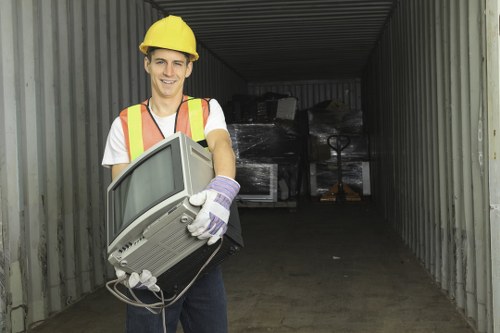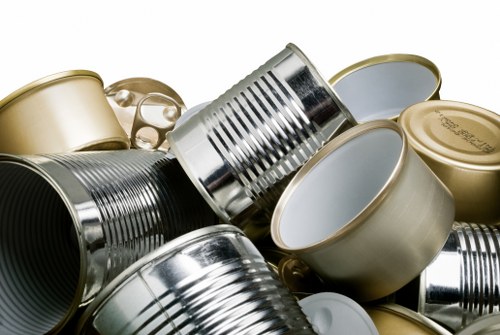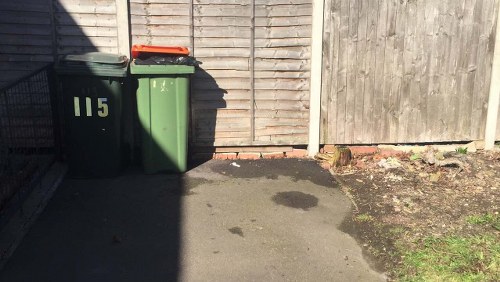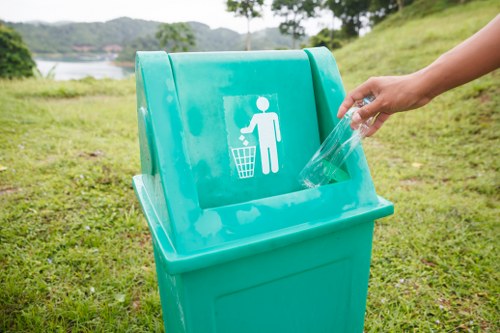Garden Clearance in Rubbish Removal Waste
Introduction to Garden Clearance

Gardening enthusiasts and homeowners alike often reach a point where garden clearance becomes a necessary task. Whether you're preparing for a new planting season, renovating your outdoor space, or simply decluttering, effective garden clearance is essential. This process involves the removal of various types of garden waste, ensuring that your outdoor area remains clean, safe, and aesthetically pleasing.
Understanding the importance of garden clearance in rubbish removal waste management is crucial. Not only does it help maintain the beauty and functionality of your garden, but it also plays a significant role in environmental conservation. Proper disposal of garden waste can prevent pollution, reduce landfill usage, and promote recycling and composting.
In this comprehensive guide, we'll explore the essentials of garden clearance, the types of waste involved, and the best practices for efficient rubbish removal. Whether you're a seasoned gardener or a homeowner embarking on garden maintenance for the first time, this article will provide valuable insights to help you manage your garden waste effectively.
Understanding Garden Waste

Garden waste encompasses a wide range of materials that accumulate from various gardening activities. This includes plant trimmings, leaves, branches, soil, grass clippings, and even old garden furniture or tools that are no longer in use.
Properly categorizing garden waste is the first step in effective rubbish removal. Common categories include:
- Organic Waste: This includes biodegradable materials like leaves, grass, and plant cuttings that can be composted.
- Inorganic Waste: Items such as broken garden equipment, plastic pots, and other non-biodegradable materials that require special disposal methods.
- Hazardous Waste: Items like pesticides, fertilizers, and certain chemicals that need to be handled with care.
Understanding these categories helps in determining the appropriate disposal or recycling methods, ensuring compliance with local regulations and environmental standards.
Additionally, knowing the types of garden waste you generate can aid in planning your clearance process, making it more efficient and less time-consuming.
Benefits of Professional Garden Clearance

While some homeowners may choose to handle garden clearance independently, hiring professional rubbish removal services offers numerous advantages. Professionals bring expertise, equipment, and resources that ensure the job is done effectively and efficiently.
Key benefits include:
- Time-Saving: Professionals can complete the clearance process much faster, allowing you to focus on other important tasks.
- Proper Disposal: Experts are knowledgeable about local disposal regulations, ensuring that all waste is handled appropriately and environmentally responsibly.
- Safety: Removing large or hazardous items can be risky. Professionals have the necessary training and equipment to perform these tasks safely.
- Comprehensive Service: From collection to disposal, professional services offer a complete solution, often including recycling and composting options.
By opting for professional garden clearance, you not only ensure a cleaner and safer garden space but also contribute to sustainable waste management practices.
Step-by-Step Garden Clearance Process

Effective garden clearance involves several steps, each essential for thorough rubbish removal and waste management. Here's a detailed breakdown:
- Assessment: Evaluate the extent of garden waste and identify the types of materials that need to be removed.
- Sorting: Separate waste into categories such as organic, inorganic, and hazardous to determine the appropriate disposal methods.
- Collection: Gather all the sorted waste, ensuring that larger items are safely and efficiently handled.
- Transportation: Move the collected waste to designated disposal or recycling centers, adhering to local regulations.
- Disposal/Recycling: Dispose of the waste responsibly or recycle materials where possible, minimizing environmental impact.
Following these steps ensures a systematic approach to garden clearance, promoting efficiency and sustainability.
Additionally, keeping track of the waste removal process can help in maintaining your garden's cleanliness and preventing future accumulation of debris.
Environmental Impact of Garden Waste

Garden waste, if not managed properly, can have significant environmental repercussions. Accumulated waste can lead to soil degradation, water pollution, and the spread of pests and diseases.
Proper garden clearance and rubbish removal mitigate these risks by ensuring that waste is disposed of in an environmentally friendly manner. Composting organic waste, for example, recycles nutrients back into the soil, enhancing its fertility and structure.
Recycling inorganic materials reduces the demand for new resources, conserving energy and reducing greenhouse gas emissions. Moreover, responsible disposal of hazardous waste prevents contamination of water sources and soil, safeguarding both the environment and public health.
By prioritizing sustainable garden waste management practices, homeowners can make a positive impact on their local ecosystem and contribute to broader environmental conservation efforts.
Integrating eco-friendly methods into your garden clearance routine not only benefits the environment but also promotes a healthier and more vibrant garden space.
Tools and Equipment for Garden Clearance
Essential Tools
Having the right tools is crucial for efficient garden clearance. Essential equipment includes:
- Rakes and Hand Tools: For collecting leaves, grass clippings, and smaller debris.
- Pruners and Shears: To trim and cut overgrown plants and branches.
- Wheelbarrows or Garden Carts: For transporting heavy or bulky waste.
- Tarps and Containers: To organize and store sorted waste before disposal.
Advanced Equipment
- Brush Cutters and Saws: For handling thick brush, woody stems, and larger branches.
- Lawn Vacuums: To efficiently collect grass clippings and smaller debris.
- Composting Bins: To transform organic waste into nutrient-rich compost.
Investing in quality tools and equipment not only streamlines the garden clearance process but also enhances safety and effectiveness. Regular maintenance of these tools ensures their longevity and performance, making garden maintenance tasks more manageable.
Additionally, using specialized equipment can significantly reduce the physical strain associated with garden clearance, allowing for a more comfortable and productive experience.
DIY vs. Professional Garden Clearance
Deciding between a DIY approach and hiring professional services for garden clearance depends on several factors, including the scale of the project, available time, budget, and personal expertise.
DIY Garden Clearance
Taking on garden clearance yourself can be rewarding and cost-effective, especially for small to medium-sized gardens. Benefits include:
- Cost Savings: Eliminating labor costs associated with professional services.
- Personal Satisfaction: The sense of accomplishment that comes with maintaining your own garden.
However, DIY clearance may pose challenges such as the physical labor involved, potential safety risks, and the time commitment required. Additionally, without proper knowledge, you might not dispose of waste in the most environmentally friendly manner.
Professional Garden Clearance Services
Professional services offer expertise, efficiency, and comprehensive waste management solutions. They handle everything from assessment to disposal, ensuring that all waste is managed responsibly.
Moreover, professionals are equipped to handle larger projects, heavy or hazardous waste, and complex clearance tasks that might be daunting for an individual.
Ultimately, the choice between DIY and professional clearance hinges on your specific needs, resources, and preferences.
Cost Factors in Garden Clearance
The cost of garden clearance can vary widely based on several factors. Understanding these can help you budget appropriately and make informed decisions.
- Amount of Waste: More extensive gardens generate more waste, which can increase the cost of clearance.
- Type of Waste: Specialized waste, such as hazardous materials, may incur additional fees for safe disposal.
- Accessibility: Gardens that are difficult to access or have obstacles can require more time and effort, impacting the overall cost.
- Geographical Location: Prices can vary based on your location and the availability of local rubbish removal services.
- Additional Services: Extra services like recycling, composting, or disposal of large items can affect the total cost.
To manage costs effectively, it's advisable to obtain multiple quotes from reputable garden clearance providers and compare their services. Additionally, planning and organizing your garden clearance in advance can help minimize expenses.
Being transparent about your needs and expectations with service providers ensures that there are no hidden costs, allowing for a smoother clearance process.
Sustainability in Rubbish Removal Waste
Sustainability is increasingly becoming a focal point in garden clearance and rubbish removal. Adopting sustainable practices ensures that waste is managed in a way that minimizes environmental impact and promotes conservation.
- Recycling: Separating recyclable materials and ensuring they are processed appropriately reduces landfill usage.
- Composting: Turning organic waste into compost enriches soil health and reduces the need for chemical fertilizers.
- Responsible Disposal: Properly disposing of hazardous waste prevents environmental contamination and promotes public health.
- Reducing Waste: Implementing strategies to minimize waste generation, such as reusing materials, contributes to a more sustainable garden maintenance routine.
Incorporating these practices not only benefits the environment but can also lead to cost savings and a healthier garden ecosystem. Sustainable rubbish removal waste management aligns with global efforts to combat climate change and preserve natural resources.
Engaging with eco-friendly garden clearance services further enhances your commitment to environmental stewardship, making your gardening practices more responsible and impactful.
Regulations and Compliance
Garden clearance and rubbish removal are subject to various local regulations and compliance standards. Understanding these is essential to ensure that all waste is managed legally and responsibly.
- Waste Disposal Regulations: Local authorities often have specific guidelines on how different types of garden waste should be disposed of.
- Recycling Requirements: There may be mandates to recycle certain materials, such as metals, plastics, and organic waste.
- Hazardous Waste Handling: Regulations typically dictate the safe handling, storage, and disposal of hazardous materials to prevent environmental contamination.
- Permits and Licensing: In some regions, certain types of rubbish removal may require permits or licenses.
Compliance with these regulations is not only a legal obligation but also a moral responsibility to protect the environment and community health. Failure to adhere can result in fines, penalties, and environmental harm.
Engaging with professional rubbish removal services ensures that all regulatory requirements are met, providing peace of mind and safeguarding your garden clearance activities.
Choosing the Right Rubbish Removal Service
Selecting a reputable rubbish removal service is crucial for effective garden clearance. Here are some factors to consider when making your choice:
- Experience and Expertise: Look for companies with proven experience in garden clearance and rubbish removal, ensuring they can handle various types of waste.
- Licensing and Certification: Ensure the service provider holds the necessary licenses and certifications to operate legally and handle waste responsibly.
- Customer Reviews and Reputation: Positive feedback and testimonials indicate reliability and quality of service.
- Comprehensive Services: Opt for services that offer a full range of clearance and disposal options, including recycling and composting.
- Transparent Pricing: Choose companies that provide clear and upfront pricing without hidden fees.
Taking the time to research and evaluate potential rubbish removal services ensures that you partner with a provider that aligns with your needs and values.
Additionally, contacting multiple providers for quotes and consultations can help you find the best fit for your garden clearance requirements.
Preparing for Garden Clearance Day
Proper preparation can streamline the garden clearance process, making it more efficient and less stressful. Here are some tips to help you get ready:
- Clear Pathways: Ensure that access points to your garden are free from obstructions to allow for easy movement of equipment and waste.
- Sort Your Waste: Pre-sorting waste into categories (organic, inorganic, hazardous) can expedite the clearance and disposal process.
- Remove Delicate Items: Protect delicate plants or structures by temporarily moving them to a safe location.
- Communicate with Service Providers: Discuss your expectations and any specific requirements with the rubbish removal service beforehand.
Additionally, having a clear plan of action can help identify any potential challenges in advance, allowing for timely solutions and a smoother clearance day.
Organizing your garden space before the clearance team arrives ensures that the process is orderly and efficient, minimizing disruptions and maximizing productivity.
Post-Clearance Garden Maintenance
Once the garden clearance is complete, maintaining the cleanliness and order of your outdoor space is essential to prevent future waste accumulation. Here are some maintenance tips:
- Regular Weeding and Trimming: Keeping plants and shrubs well-maintained reduces the amount of debris generated.
- Composting: Establish a composting system for organic waste to recycle nutrients back into your garden.
- Proper Storage: Store gardening tools and equipment neatly to prevent clutter and damage.
- Seasonal Cleanups: Perform thorough cleanups during each season to address specific waste generation patterns.
Implementing these maintenance practices ensures that your garden remains tidy and reduces the need for extensive clearance in the future.
Moreover, consistent upkeep promotes a healthier garden ecosystem, enhancing plant growth and overall garden aesthetics.
Innovations in Rubbish Removal
The field of rubbish removal is continually evolving, with innovations aimed at improving efficiency, sustainability, and user experience. Some notable advancements include:
- Smart Waste Management Systems: Utilizing technology to optimize waste collection routes and schedules.
- Eco-Friendly Disposal Methods: Developing new recycling processes and materials to reduce environmental impact.
- Automated Sorting Facilities: Enhancing the accuracy and speed of waste sorting through automation.
- Green Collection Vehicles: Employing electric or hybrid vehicles to minimize carbon emissions during waste transportation.
Staying informed about these innovations allows both rubbish removal services and homeowners to adopt more effective and sustainable practices in garden clearance.
Embracing technological advancements can lead to more efficient waste management, cost savings, and a reduced ecological footprint.
Common Challenges in Garden Clearance
Garden clearance, while essential, can present several challenges that may complicate the process. Being aware of these obstacles can help in devising effective solutions:
- Large Volume of Waste: Managing and transporting a significant amount of garden waste can be time-consuming and labor-intensive.
- Hard-to-Reach Areas: Clearing waste from confined or elevated spaces may require specialized equipment and expertise.
- Handling Hazardous Materials: Safely disposing of chemicals and other hazardous substances necessitates strict adherence to safety protocols.
- Weather Conditions: Inclement weather can impede the clearance process and affect the condition of the waste.
- Disposal Limitations: Local regulations may restrict the types and quantities of waste that can be disposed of in certain locations.
Addressing these challenges involves careful planning, the use of appropriate tools and equipment, and collaboration with professional rubbish removal services.
Additionally, having contingency plans in place can help mitigate the impact of unexpected obstacles, ensuring a smooth and efficient garden clearance process.
The Future of Garden Clearance and Waste Management
The future of garden clearance and rubbish removal is poised for significant transformation, driven by technological advancements and a growing emphasis on sustainability. Key trends include:
- Increased Automation: The adoption of automated machinery and robotics to handle repetitive and labor-intensive tasks.
- Enhanced Recycling Technologies: Innovations that make recycling garden waste more efficient and effective.
- Community-Based Initiatives: Localized programs that promote recycling, composting, and responsible waste disposal within communities.
- Educational Campaigns: Raising awareness about the importance of proper garden waste management and sustainable practices.
Embracing these developments can lead to more efficient, cost-effective, and environmentally friendly garden clearance processes. As society continues to prioritize sustainability, the rubbish removal industry will play a pivotal role in shaping responsible waste management practices.
Staying abreast of these trends allows homeowners and service providers to adapt and implement strategies that align with future sustainability goals.
Conclusion
Garden clearance in rubbish removal waste management is an integral aspect of maintaining a healthy and beautiful outdoor space. By understanding the types of garden waste, the benefits of professional services, and the best practices for clearance and disposal, homeowners can effectively manage their garden waste while contributing to environmental sustainability.
Emphasizing responsible waste management not only preserves the aesthetic and functionality of your garden but also supports broader ecological conservation efforts. Whether you choose a DIY approach or enlist professional assistance, prioritizing efficient and sustainable garden clearance is essential for long-term garden health and environmental well-being.
Contact us today to learn more about our professional garden clearance and rubbish removal services, and take the first step towards a cleaner, greener garden.



